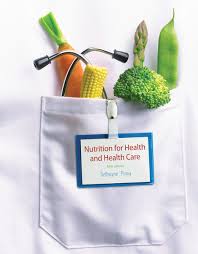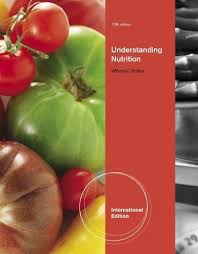Description
Test Bank For Nutrition for Health and Health Care 5th Edition by Linda Kelley DeBruyne
Chapter 3 – Carbohydrates
True/False
1. Whenever carbohydrate is available to the body, the human brain depends exclusively on it as an energy source.
2. Most dietary fiber provides little or no energy.
3. A client consumes 2600 kcalories per day and 50 grams of carbohydrate from concentrated sweets. This client’s sugar intake falls within the same range as added sugar intakes for the USDA Food Patterns recommendations.
4. Experts agree that moderate amounts of sugar in the diet may pose a number of major health risks.
5. A client consumes 2000 kcalories per day and 200 grams of carbohydrate. This person meets the current dietary recommendations for carbohydrate intake.
6. Cindy consumed 1 cup of vegetables, 1 cup of fruit, 5 ounces of whole grains, and 1 cup of legumes during the day. Cindy met the DV recommendation for fiber for the day.
Multiple Choice
1. The main function of carbohydrates in the body is to:
a. furnish the body with energy.
b. provide material for synthesizing cell walls.
c. synthesize fat.
d. insulate the body to prevent heat loss.
2. High-fructose corn syrup and fruit juice concentrate are examples of _____.
a. starches
b. disaccharides
c. added sugars
d. fibers
3. The _____ are the basic units of all carbohydrates.
a. monosaccharides
b. disaccharides
c. polysaccharides
d. sucrose molecules
4. Three monosaccharides important in nutrition are:
a. glucose, lactose, and fructose.
b. fructose, glucose, and sucrose.
c. maltose, fructose, and lactose.
d. galactose, sucrose, and lactose.
e. fructose, glucose, and galactose.
5. The primary source of energy for the brain and nervous system under normal conditions is:
a. sucrose.
b. amino acids.
c. fructose.
d. glucose.
e. fatty acids.
6. The hormone that moves glucose from the blood into the cells is:
a. glucagon.
b. insulin.
c. testosterone.
d. sucrose.
7. Which of the following does not come exclusively from plants?
a. glucose
b. maltose
c. fructose
d. galactose
8. Fructose is:
a. the sweetest of the sugars.
b. known as milk sugar.
c. abundant in whole grains.
d. also known as dextrose.
9. Fructose occurs naturally in:
a. bread.
b. milk.
c. meats.
d. fruits.
10. Which monosaccharide is found most often in nature as a part of a disaccharide?
a. glucose
b. fructose
c. maltase
d. galactose
11. Which of the following compounds is a disaccharide?
a. glucose
b. fructose
c. lactose
d. galactose
12. What happens when blood glucose falls too low?
a. glucagon promotes breakdown of muscle glycogen
b. glucagon promotes breakdown of liver glycogen
c. insulin promotes glycogen synthesis in the liver
d. insulin promotes glycogen synthesis in the muscle
13. The most familiar source of sucrose is:
a. bread.
b. table sugar.
c. milk.
d. meat.
e. fruit.
14. The principal carbohydrate used to sweeten homemade iced tea is:
a. fructose.
b. galactose.
c. maltose.
d. sucrose.
15. One molecule of maltose can yield _____ molecules of glucose.
a. one
b. two
c. three
d. four
16. Which of the following is the principal carbohydrate in milk?
a. galactose
b. fructose
c. sucrose
d. lactose
17. Chemically, lactose is a:
a. monosaccharide.
b. disaccharide.
c. dextrose.
d. polysaccharide.
18. An example of a polysaccharide is:
a. starch.
b. meat.
c. fruit.
d. protein.
19. Which of the following carbohydrates is a polysaccharide?
a. fructose
b. starch
c. maltose
d. lactose
20. The stored form of glucose in the body is called:
a. glycogen.
b. insulin.
c. fat.
d. muscle.
21. Polysaccharides are composed of:
a. one glucose unit.
b. two glucose units.
c. three glucose units.
d. many glucose units.
22. Excess glucose in the blood is converted into glycogen and stored primarily in the:
a. brain and liver.
b. liver and muscles.
c. blood cells and brain.
d. pancreas and brain.
23. The richest sources of starch are:
a. fruits.
b. grains.
c. vegetables.
d. soybeans.
24. Whole grains, vegetables, and fruits are rich sources of:
a. sucrose.
b. dietary fiber.
c. fat.
d. glycogen.
25. Cellulose, pectin, hemicellulose, and gums are:
a. nonnutritive sweeteners.
b. sugar alcohols.
c. fibers.
d. forms of starch.
26. _____ is a fiber found in all vegetables, fruits, and legumes.
a. Hemicelluose
b. Pectin
c. Mucilage
d. Cellulose
27. Which of the following fibers is a nonpolysaccharide?
a. cellulose
b. lignin
c. pectin
d. gum
28. All of the following fibers are used by the food industry as additives or stabilizers except:
a. pectins.
b. gums.
c. lignins.
d. mucilages.
29. _____ escape digestion and absorption in the small intestine.
a. Resistant starches
b. Polysaccharides
c. Bacteria
d. Disaccharides
30. Fibers are categorized by:
a. the type of chemical bonds that hold them together.
b. their chemical and physical properties.
c. the number of hydrogen molecules they contain.
d. their ability to be digested by human enzymes.
31. The sugars in fruits, vegetables, grains, and milk are:
a. usually added to these foods.
b. considered discretionary kcalories.
c. naturally occurring.
d. resistant to digestion.
32. The steady upward trend in sugar consumption among Americans can be attributed to:
a. consumer demand.
b. food manufacturers.
c. better food preservation techniques.
d. improved food safety practices.
33. The leading source of added sugars in the American diet is:
a. baked goods such as cookies and cakes.
b. fruit packed in heavy syrup.
c. soft drinks and other sugar-sweetened beverages.
d. chocolate bars and other candy treats.
34. According to the World Health Organization’s recommendations, no more than _____% of daily kcalories should come from added sugars.
a. 5
b. 10
c. 15
d. 20
35. Which of the following statements best describes the role of sugar in the development of obesity?
a. Sugar consumption is a direct cause of weight gain leading to obesity.
b. The increased use of added sugars by food manufacturers is the cause of obesity.
c. Sugar contributes to obesity when it is part of excessive energy intakes.
d. There is no correlation between the consumption of added sugars and the rise in obesity.
36. Which of the following statements about excessive sugar consumption is true?
a. It causes cancer.
b. It causes heart disease.
c. It causes dental caries.
d. It causes hyperactive behavior in children.
37. Which of the following ingredients is a sugar alcohol?
a. polydextrose
b. maltitol
c. cellulose
d. aspartame
38. In the small intestine, _____ from the _____ breaks starch into maltose.
a. bacterial enzymes; colon
b. maltase; intestinal cells
c. amylase; pancreas
d. amylase; salivary glands
39. Sweeteners that yield energy are called:
a. nutritive sweeteners.
b. alternative sweeteners.
c. resistant sweeteners.
d. glycemic sweeteners.
Use this information for questions 40-41:
A carton of ice cream displays the following list of ingredients: milkfat and nonfat milk, sorbitol, pecans, cellulose, butter, caramel color, citric acid, aspartame, carrageenan.
40. How many alternative sweeteners are contained in this product?
a. one
b. two





Be the first to review “Test Bank For Nutrition for Health and Health Care 5th Edition by Linda Kelley DeBruyne”